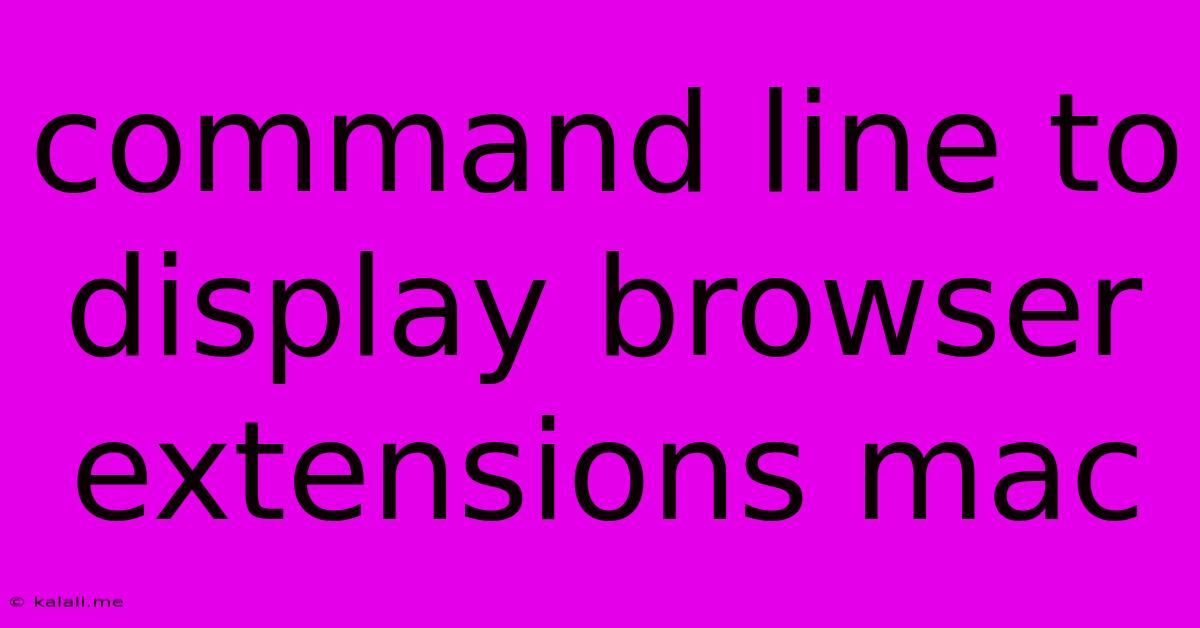Command Line To Display Browser Extensions Mac
Kalali
Jun 07, 2025 · 3 min read

Table of Contents
Unveiling Your Mac's Hidden Browser Extensions: A Command-Line Approach
Finding out which browser extensions you have installed can sometimes feel like searching for a needle in a haystack. While most browsers offer a user-friendly interface to manage extensions, did you know you can also use the command line on your Mac to reveal this information? This approach offers a powerful, quick, and efficient way to manage your browser extensions, especially helpful for troubleshooting or scripting. This guide will show you how to access this information for popular browsers like Chrome, Firefox, and Safari.
This article will cover command line techniques for identifying installed browser extensions on macOS, offering a streamlined approach to extension management compared to traditional GUI methods. We'll discuss the advantages of using the command line, explore the specific commands for different browsers, and address potential troubleshooting issues.
Why Use the Command Line for Extension Management?
While graphical user interfaces (GUIs) provide a visual and intuitive way to manage extensions, the command line offers several advantages:
- Speed and Efficiency: Executing a single command is significantly faster than navigating through menus and dialog boxes, especially when dealing with multiple extensions or frequent checks.
- Automation: Command-line tools can be integrated into scripts for automated tasks, such as regular extension checks or automated updates.
- Scripting and Automation: For developers or power users, the command line allows integration with scripting languages like Bash or Python for advanced automation tasks.
- Troubleshooting: Identifying and verifying installed extensions can be crucial for diagnosing browser performance issues or conflicts.
Accessing Browser Extension Information: A Browser-Specific Guide
The approach to accessing extension information varies depending on the browser. Below, we outline the common methods for Chrome, Firefox, and Safari. Note: These methods may require administrator privileges in some cases, so be prepared to enter your password if prompted.
Chrome (Chromium-based browsers):
Chrome doesn't directly expose extension information via the command line in a readily accessible manner. Its extension management is primarily GUI-based. To find your extensions, you'll need to access Chrome's extension management page directly through the browser.
Firefox:
Unfortunately, similar to Chrome, Firefox's extension management isn't directly accessible through command-line tools. You'll need to manage extensions through the browser's GUI.
Safari:
Safari extensions are managed through the system settings. There isn't a direct command-line interface to view the list.
Alternative Approaches and Further Exploration
While direct command-line access to extension lists is limited for major browsers on macOS, consider these alternatives:
- Reviewing Browser Profiles: Exploring the browser's profile directory might reveal some extension-related files. However, this is not a reliable or recommended method, as the file structure and content can change between browser versions.
- Using Third-Party Tools: There may be third-party command-line tools or scripts developed by the community that could provide this functionality. However, exercise caution when using third-party tools and always verify their legitimacy.
Conclusion
Managing browser extensions via the command line on macOS presents a powerful yet sometimes limited approach. While direct command-line access to extension lists is not commonly supported by major browsers like Chrome, Firefox, and Safari, understanding the limitations and exploring alternative approaches will enhance your overall browser management skills. Remember to always prioritize using official browser interfaces for managing extensions to ensure security and stability.
Latest Posts
Latest Posts
-
How To Fix Ripped Drywall Paper
Jun 08, 2025
-
Find Position From Velocity Time Graph
Jun 08, 2025
-
Shes Like A Dog Bone To Me Meaning
Jun 08, 2025
-
Folder Of An Image Layer In Gimp
Jun 08, 2025
Related Post
Thank you for visiting our website which covers about Command Line To Display Browser Extensions Mac . We hope the information provided has been useful to you. Feel free to contact us if you have any questions or need further assistance. See you next time and don't miss to bookmark.